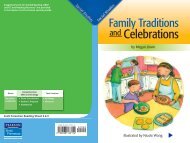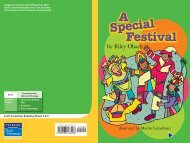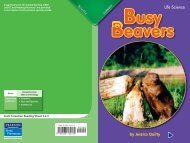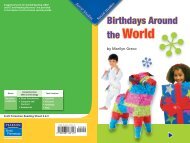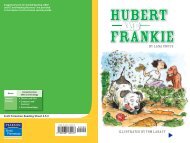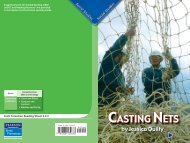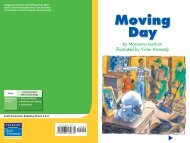Baseball Heroes.pdf - dhnar - home
Baseball Heroes.pdf - dhnar - home
Baseball Heroes.pdf - dhnar - home
- No tags were found...
Create successful ePaper yourself
Turn your PDF publications into a flip-book with our unique Google optimized e-Paper software.
Suggested levels for Guided Reading, DRA, <br />
Lexile, ® and Reading Recovery are provided<br />
in the Pearson Scott Foresman Leveling Guide.<br />
Biography<br />
<strong>Baseball</strong><br />
<strong>Heroes</strong><br />
by Greg Rogers<br />
Genre<br />
Biography<br />
Comprehension<br />
Skills and Strategy<br />
• Compare and<br />
Contrast<br />
• Cause and Effect<br />
• Visualize<br />
Text Features<br />
• Captions<br />
• Chapter titles<br />
• Glossary<br />
Scott Foresman Reading Street 2.6.1<br />
ì
Reader Response<br />
<strong>Baseball</strong> <strong>Heroes</strong><br />
1. Compare the major leagues with the<br />
Negro leagues. Use a graphic organizer<br />
by Greg Rogers<br />
like the one below to organize your<br />
ideas.<br />
Major leagues<br />
Negro leagues<br />
2. Read the first six lines on page 11. Make<br />
a picture in your mind about what the<br />
words are describing. What do you see<br />
3. The word talented is used in this book.<br />
Use the glossary to find out the word’s<br />
meaning. What are you talented in<br />
4. What evidence does the book give<br />
that people’s thinking about African<br />
American baseball players was<br />
changing Look at pictures as well as<br />
the words.<br />
Editorial Offices: Glenview, Illinois • Parsippany, New Jersey • New York, New York<br />
Sales Offices: Needham, Massachusetts • Duluth, Georgia • Glenview, Illinois<br />
Coppell, Texas • Ontario, California • Mesa, Arizona
CONTENTS<br />
CHAPTER 1 4<br />
Playing Separately<br />
CHAPTER 2 6<br />
Jackie Robinson<br />
CHAPTER 3 10<br />
Willie Howard Mays<br />
Every effort has been made to secure permission and provide appropriate credit for<br />
photographic material. The publisher deeply regrets any omission and pledges to<br />
correct errors called to its attention in subsequent editions.<br />
Unless otherwise acknowledged, all photographs are the property of Scott Foresman,<br />
a division of Pearson Education.<br />
Photo locators denoted as follows: Top (T), Center (C), Bottom (B), Left (L), Right (R),<br />
Background (Bkgd)<br />
CHAPTER 4 14<br />
Hank Aaron<br />
Now Try This 18<br />
Glossary 20<br />
Opener: (T) Brand X Pictures, C) Bettmann/Corbis; 1 ©DK Images; 4 (T) Brand X Pictures<br />
(BR) Bettman/Corbis, (C) ©DK images; 5 Getty Images; 7 (T) Library of Congress, (B)<br />
Bettman/Corbis; 8 Bettmann/Corbis; 9 Bettmann/Corbis; 11 Bettmann/Corbis; 13<br />
Bettmann/Corbis; 15 Bettmann/Corbis; 16 Bettmann/Corbis; 17 Bettmann/Corbis; 18<br />
Library of Congress<br />
ISBN: 0-328-13309-4<br />
Copyright © Pearson Education, Inc.<br />
All Rights Reserved. Printed in the United States of America. This publication is<br />
protected by Copyright, and permission should be obtained from the publisher<br />
prior to any prohibited reproduction, storage in a retrieval system, or transmission<br />
in any form by any means, electronic, mechanical, photocopying, recording, or<br />
likewise. For information regarding permission(s), write to: Permissions Department,<br />
Scott Foresman, 1900 East Lake Avenue, Glenview, Illinois 60025.<br />
2 3 4 5 6 7 8 9 10 V010 14 13 12 11 10 09 08 07 06 05<br />
3
Chapter One: Playing Separately<br />
Before the 1940s, African American<br />
baseball players faced many challenges.<br />
From 1884 until 1945 they were banned<br />
from major league and minor league baseball<br />
because they were black. During this time,<br />
African American players decided to start<br />
their own teams. They formed leagues, or<br />
groups of teams, that came to be known<br />
as the Negro leagues. Negro league players<br />
were professionals, but they earned much less<br />
money than white players.<br />
Playing in separate leagues was unfair.<br />
It was the result of prejudice. Many people<br />
fought to end the prejudice that kept black<br />
players from playing with white players.<br />
Finally, in 1945, the first African American<br />
player was invited to join a major league team.<br />
You will read about three of the greatest<br />
African American baseball players—Jackie<br />
Robinson, Willie Howard Mays, and<br />
Hank Aaron .<br />
Willie Howard<br />
Mays<br />
4<br />
Hank Aaron<br />
Jackie Robinson<br />
5
Chapter Two: Jackie Robinson<br />
Jack Roosevelt Robinson, called Jackie,<br />
was the first African American baseball<br />
player to join a major league team. Jackie<br />
Robinson was born in Georgia in 1919. He<br />
grew up in California and went to college<br />
there. He was one of the best athletes in<br />
college sports. He played varsity football,<br />
basketball, and baseball.<br />
After college, Jackie Robinson joined the<br />
army and fought during World War II. When<br />
the war ended, he joined the Kansas City<br />
Monarchs. The Monarchs were one of the<br />
best Negro league baseball teams.<br />
The Brooklyn Dodgers, a major league<br />
team, first noticed Jackie Robinson when he<br />
played shortstop for the Monarchs. It was<br />
clear that he was very talented. Still, the<br />
Dodgers waited many months to ask him to<br />
play for them. They needed to think about<br />
facing the pressure of being the first major<br />
league team to sign a Negro league player.<br />
Jackie Robinson<br />
was a great<br />
athlete in many<br />
sports.<br />
6<br />
7
Jackie Robinson was asked to join the<br />
Dodgers in 1945. In 1947 Jackie played first<br />
base in his first major league game at Ebbets<br />
Field. Though he did not get a hit at the<br />
plate, he went to first base on a pitching error<br />
and scored the winning run for the Dodgers.<br />
Jackie was treated badly by many people<br />
during his rookie season. Some fans and even<br />
some other players were very prejudiced. But<br />
Jackie played and handled this prejudice so<br />
well that he was voted Rookie of the Year.<br />
Jackie Robinson played major league<br />
baseball with the Dodgers for ten years. He<br />
led the National League in batting. He played<br />
in the All-Star game six times. That was a<br />
major league record. He also helped change<br />
people’s ideas about African American<br />
athletes.<br />
In 1949 he was named Most Valuable<br />
Player, and he was elected to the <strong>Baseball</strong><br />
Hall of Fame in 1962. Jackie Robinson is a<br />
hero. He is honored for his ability to play<br />
baseball but also for staying calm and focused<br />
when facing challenges.<br />
8 9
Chapter Three: Willie Howard Mays<br />
After Jackie Robinson joined the Brooklyn<br />
Dodgers, other major league teams asked<br />
talented African American players to join<br />
them. One of these players was center fielder<br />
Willie Mays.<br />
Willie Howard Mays, nicknamed the Say<br />
Hey Kid, was born in Alabama in 1931. The<br />
son of a baseball player, Willie Mays had<br />
played baseball since childhood. He began<br />
playing in the Negro leagues at the age of<br />
sixteen, when he was still in high<br />
school.<br />
Willie Mays joined the New<br />
York Giants in 1950. Willie Mays hit<br />
twenty <strong>home</strong> runs in his first year and<br />
was named Rookie of the Year .<br />
He made many famous plays in center<br />
field. In Pennsylvania, Mays sailed across the<br />
outfield, racing to catch a fly ball that was hit<br />
almost five hundred feet away. He lost his<br />
baseball glove, but he managed to catch the<br />
ball with his bare hand! What an effort!<br />
Willie Mays was a great player in the<br />
field. He was a powerful hitter at the plate<br />
and a very fast runner around the bases.<br />
Willie Mays’s talent helped lead the Giants to<br />
the 1951 World Series.<br />
Willie Mays scores again!<br />
10<br />
11
During the 1954 World Series, Mays<br />
made one of the greatest catches in the<br />
history of baseball. This catch came in game<br />
one against the Cleveland Indians. A batter<br />
hit a towering fly ball deep to center field.<br />
Mays made a backward catch after running<br />
from hundreds of feet away!<br />
The Giants moved to San Francisco in<br />
1958, and Willie Mays went with them. He<br />
was soon receiving the highest salary of any<br />
baseball player of that time. In 1972 Willie<br />
Mays returned to New York, where he played<br />
for the New York Mets until he retired at age<br />
forty-two.<br />
Willie Mays was one of the most popular<br />
baseball players in history. He won many<br />
awards, played in twenty-four All-Star games,<br />
and hit more than six hundred <strong>home</strong> runs.<br />
He was elected Most Valuable Player two<br />
times and won twelve Gold Glove awards.<br />
Willie Mays was elected to the <strong>Baseball</strong> Hall<br />
of Fame in 1979.<br />
12<br />
13
Chapter Four: Hank Aaron<br />
Henry Louis “Hank” Aaron was another<br />
talented baseball player from the Negro<br />
leagues. Hank Aaron was born in Alabama in<br />
1934. In 1954 Hank Aaron joined the Atlanta<br />
Braves after two years in the Negro leagues.<br />
He hit a <strong>home</strong> run his first at bat!<br />
During his last season with the Braves,<br />
Hank Aaron would break one of the greatest<br />
baseball records of his time. Many people<br />
thought it was a record that could never be<br />
broken. It was Babe Ruth’s all-time career<br />
<strong>home</strong>-run hitting record of 714 <strong>home</strong> runs.<br />
As Hank Aaron got closer to breaking<br />
Babe Ruth’s record, he started getting angry<br />
letters and phone calls. Many people did<br />
not want to see an African American player<br />
break a record held by a famous white<br />
baseball player. Hank Aaron continued to<br />
fight against their prejudice and beat the<br />
record. Aaron’s talent inspired many people<br />
on and off the field.<br />
14<br />
15
In 1974 Hank Aaron left the Braves to<br />
join the Milwaukee Brewers. He played two<br />
years for the Brewers before retiring in 1976.<br />
By the time Hank Aaron retired, he led<br />
the major leagues in <strong>home</strong> runs. He also held<br />
many all-time records. He had played in the<br />
most games, had the most at bats, and had<br />
the most base hits.<br />
In 1982 Hank Aaron was elected to<br />
the <strong>Baseball</strong> Hall of Fame. He was the last<br />
African American player to come to the<br />
major leagues from the Negro leagues.<br />
Hank Aaron’s Hall of Fame ceremony<br />
Jackie Robinson, Willie Mays, and Hank<br />
Aaron were very talented ballplayers. Jackie<br />
Robinson and Hank Aaron were two of the<br />
best hitters ever to play. Willie Mays was an<br />
amazing fielder with lightning speed.<br />
These athletes made history. Jackie<br />
Robinson, Willie Mays, and Hank Aaron<br />
faced prejudice and challenges to gain the<br />
right to play the sport they loved. Even at<br />
difficult times, their talent showed through.<br />
Their courage inspires us and makes us proud<br />
today.<br />
Jackie Robinson signs autographs for fans.<br />
16<br />
17
Now Try This<br />
Time Line: Important Events<br />
In <strong>Baseball</strong><br />
There have been some important events<br />
in the history of baseball. A time line is a line<br />
that shows events happening in order. Make<br />
a time line to show what you learned about<br />
baseball history.<br />
Here’s How to Do It!<br />
1. Make a list of the years and events<br />
mentioned in this book.<br />
2. Place your events in order.<br />
3. Get a long sheet of paper.<br />
4. Draw a line from left to right across the<br />
middle of your paper.<br />
5. Mark this line with a large dot for each of<br />
the years on your list.<br />
6. Write down the events in the order they<br />
happened in time.<br />
7. Choose a few events to illustrate.<br />
8. Present your time line to the class.<br />
18<br />
19
Glossary<br />
athletes n. people<br />
trained in sports.<br />
banned v.<br />
forbidden by law.<br />
challenges n.<br />
things that test<br />
our abilities<br />
or character;<br />
difficulties.<br />
effort n. the use<br />
of concentration<br />
and energy to do<br />
something; trying<br />
hard.<br />
prejudice n. an<br />
unreasonable<br />
dislike of a group<br />
of people.<br />
record n. the best<br />
number, rate, or<br />
speed yet reached.<br />
rookie n. player in<br />
his or her first year<br />
of professional<br />
athletics; beginner.<br />
talented adj.<br />
skillful; able to do<br />
something very<br />
well.<br />
Reader Response<br />
1. Compare the major leagues with the<br />
Negro leagues. Use a graphic organizer<br />
like the one below to organize your<br />
ideas.<br />
Major leagues<br />
Negro leagues<br />
2. Read the first six lines on page 11. Make<br />
a picture in your mind about what the<br />
words are describing. What do you see<br />
3. The word talented is used in this book.<br />
Use the glossary to find out the word’s<br />
meaning. What are you talented in<br />
4. What evidence does the book give<br />
that people’s thinking about African<br />
American baseball players was<br />
changing Look at pictures as well as<br />
the words.<br />
20




